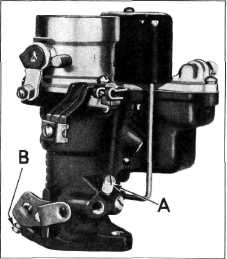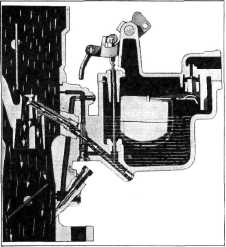1942 - 1947 CHEVROLET SHOP MANUAL
Section 6 - Engine
|
|
|||
|
6-37 |
|||
|
|
|||
|
Low Speed
At low
engine speed the throttle is partly open and suction from the down stroke of the
engine piston draws air in
through the air horn. The air in passing through the main venturi
increases in velocity with the
result that the suction is increased over the secondary venturi. This increased
air speed through the secondary venturi in turn steps up the suction on the primary venturi and
thereby increases the air speed
in the primary venturi. The air, passing through the primary venturi,
draws gasoline from the main nozzle where it is mixed with the air passing through the primary,
secondary and main venturi forming a finely atomized mixture which then passes on to the
manifold and cylinders. Fig.
76. |
There are
two adjustments on the carburetor, one for idling mixture, "A" in Fig. 77,
and the other for idling speed, "B"
in Fig. 77. Both of these adjustments should be made
together.
To adjust
the idling mixture, proceed as follows: Open the idle adjusting screw "A"
from1/2 to 1
turn. Allow the engine to idle. Try turning the screw both ways from this position until
the best setting is
reached. |
||
 |
|||
 |
|||
|
Fig. 77—Carburetor Idle Adjustment
To adjust for idling speeds,
proceed as follows: With the hand
throttle on the instrument panel closed, set the throttle lever
stop screw "B" so the engine runs at
approximately 450 to 500 revolutions per minute. If the engine runs too
fast, back the screw out. If too slow, turn it in until the proper
speed is obtained.
Float Level
A 1/2" float level should
be maintained for best economy. This
measurement should be taken at the end of the float opposite the gasoline
intake needle, measured from the top of the float to the machined
underside surface of the bowl cover with the gasket removed. The 1/2" gauge
shown in Fig. 78 is a
convenient tool for making this check.
If the float level must be reset,
it should be done by bending the lip contacting the gasoline intake needle. Do not make this adjustment by
pressing on the float. Bending the lip up will lower the float
level and bending it down will raise
it. Only a slight bend is
necessary to change the float level. |
|||
|
Fig. 76—Carburetor Low Speed Operation
High Speed
The
carburetor operation at higher speeds is similar to the low speed operation with the
exception of raising the
metering rod in the metering rod jet. This serves the same purpose as
increasing the size of the jet and thereby furnishes the
additional gasoline
required for high speeds and wide-open throttle power
operation.
CARBURETOR ADJUSTMENT
All
carburetors are carefully tested and adjusted to the engine, before leaving the factory.
Too often adjustments are made on the carburetor, when in reality, something else is causing uneven
running, or the engine has not
thoroughly warmed up. |
|||
|
|
|||